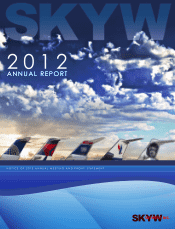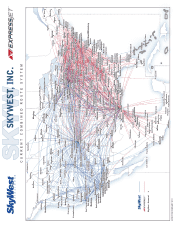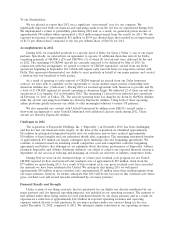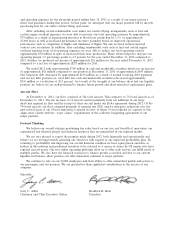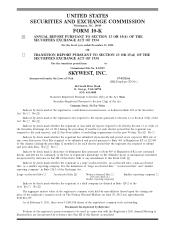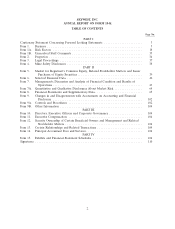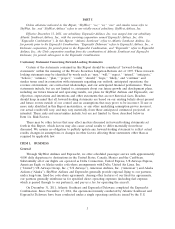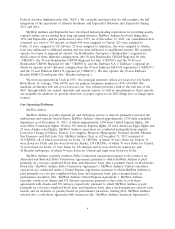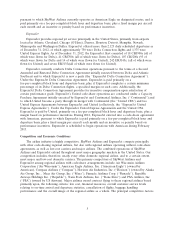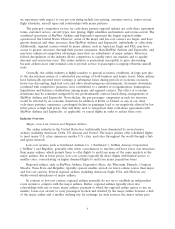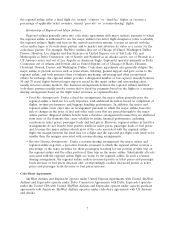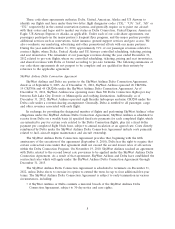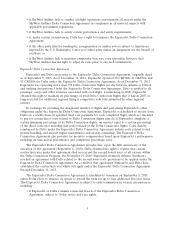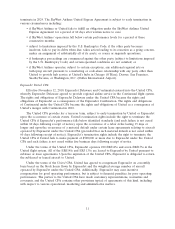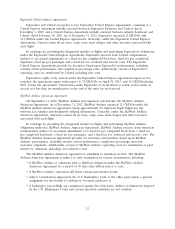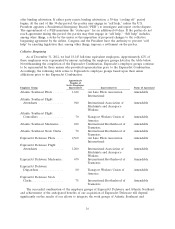SkyWest Airlines 2012 Annual Report Download - page 10
Download and view the complete annual report
Please find page 10 of the 2012 SkyWest Airlines annual report below. You can navigate through the pages in the report by either clicking on the pages listed below, or by using the keyword search tool below to find specific information within the annual report.we experience with respect to our pro-rate flying include fare pricing, customer service, routes served,
flight schedules, aircraft types and relationships with major partners.
The principal competitive factors for code-share partner regional airlines are code-share agreement
terms, customer service, aircraft types, fare pricing, flight schedules and markets and routes served. The
combined operations of SkyWest Airlines and ExpressJet represent the largest regional airline
operation in the United States. However, some of the major and low-cost carriers are larger, and have
greater financial and other resources than SkyWest Airlines and ExpressJet, individually or collectively.
Additionally, regional carriers owned by major airlines, such as American Eagle and PSA, may have
access to greater resources, through their parent companies, than SkyWest Airlines and ExpressJet, and
may have enhanced competitive advantages since they are subsidiaries of major airlines. Moreover,
federal deregulation of the industry allows competitors to rapidly enter our markets and to quickly
discount and restructure fares. The airline industry is particularly susceptible to price discounting
because airlines incur only nominal costs to provide service to passengers occupying otherwise unsold
seats.
Generally, the airline industry is highly sensitive to general economic conditions, in large part due
to the discretionary nature of a substantial percentage of both business and leisure travel. Many airlines
have historically reported lower earnings or substantial losses during periods of economic recession,
heavy fare discounting, high fuel costs and other disadvantageous environments. Economic downturns,
combined with competitive pressures, have contributed to a number of reorganizations, bankruptcies,
liquidations and business combinations among major and regional carriers. The effect of economic
downturns may be somewhat mitigated by the predominantly contract-based flying arrangements of
SkyWest Airlines and ExpressJet. Nevertheless, the per-passenger component in such fee structure
would be affected by an economic downturn. In addition, if Delta or United, or any of our other
code-share partners, experience a prolonged decline in passenger load or are negatively affected by low
ticket prices or high fuel prices, they will likely seek to renegotiate their code-share agreements with
SkyWest Airlines and ExpressJet, as applicable, or cancel flights in order to reduce their costs.
Industry Overview
Majors, Low-Cost Carriers and Regional Airlines
The airline industry in the United States has traditionally been dominated by several major
airlines, including American, Delta, US Airways and United. The major airlines offer scheduled flights
to most major U.S. cities, numerous smaller U.S. cities, and cities throughout the world through a hub
and spoke network.
Low-cost carriers, such as Southwest Airlines Co. (‘‘Southwest’’), JetBlue Airways Corporation
(‘‘JetBlue’’) and Republic, generally offer fewer conveniences to travelers and have lower cost structures
than major airlines, which permits them to offer flights to and from many of the same markets as the
major airlines, but at lower prices. Low-cost carriers typically fly direct flights with limited service to
smaller cities, concentrating on higher demand flights to and from major population bases.
Regional airlines, such as SkyWest Airlines, ExpressJet, Mesa, Air Wisconsin, Pinnacle, Compass,
Mesaba, Trans State and Republic, typically operate smaller aircraft on lower-volume routes than major
and low-cost carriers. Several regional airlines, including American Eagle, PSA, and Horizon, are
wholly-owned subsidiaries of major airlines.
In contrast to low-cost carriers, regional airlines generally do not try to establish an independent
route system to compete with the major airlines. Rather, regional airlines typically enter into
relationships with one or more major airlines, pursuant to which the regional airline agrees to use its
smaller, lower-cost aircraft to carry passengers booked and ticketed by the major airline between a hub
of the major airline and a smaller outlying city. In exchange for such services, the major airline pays
6

